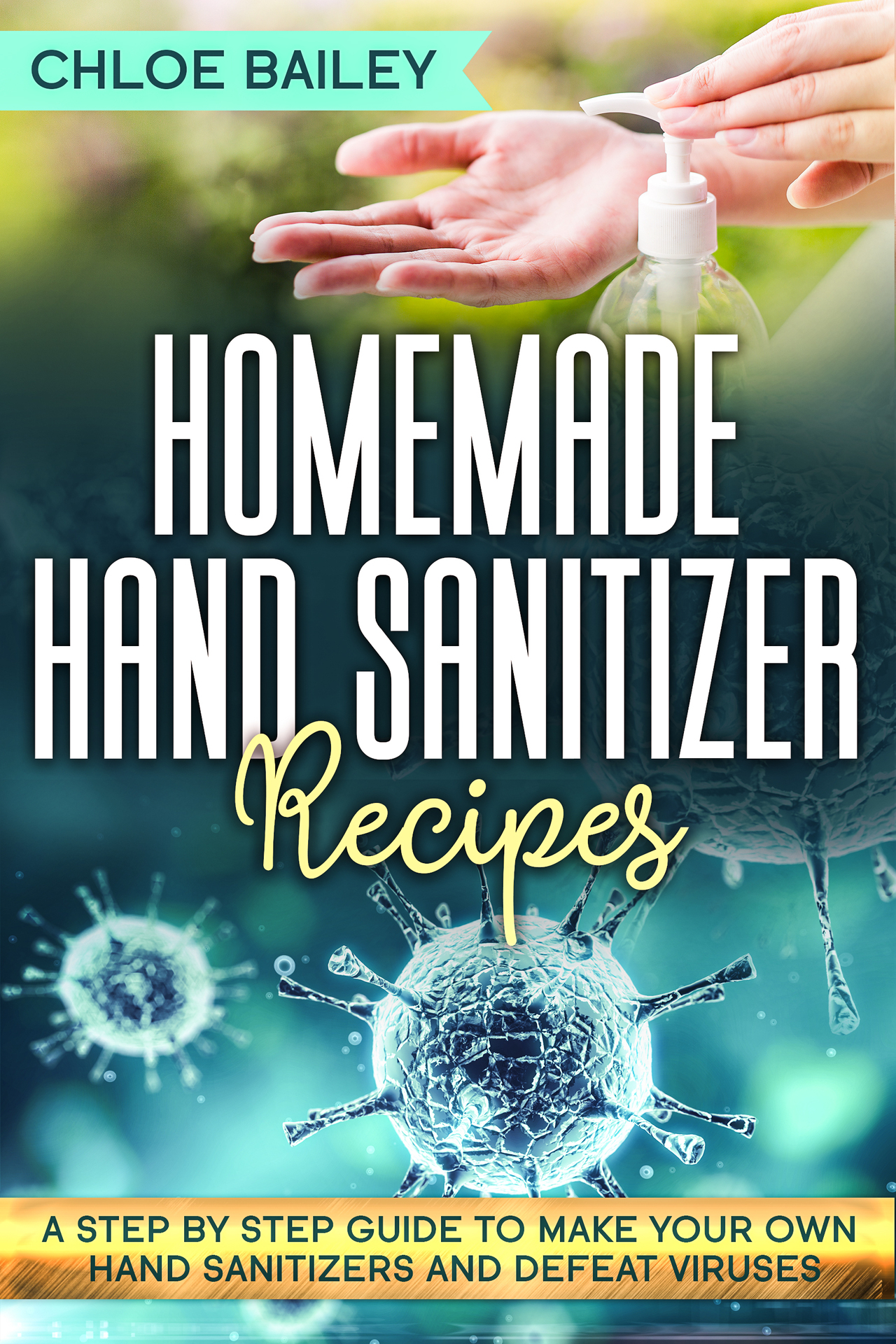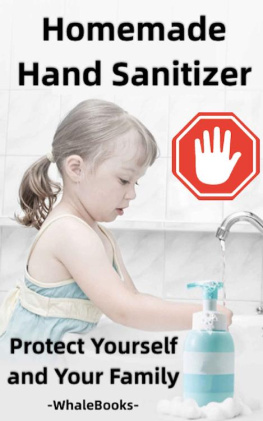Homemade Hand Sanitizer
A Step By Step Guide to Make Your Own Hand Sanitizers and Stay Healthy
Chloe Bailey
Copyright 2020 - All rights reserved.
The content contained within this book may not be reproduced, duplicated or transmitted without direct written permission from the author or the publisher.
Under no circumstances will any blame or legal responsibility be held against the publisher, or author, for any damages, reparation, or monetary loss due to the information contained within this book, either directly or indirectly.
Legal Notice:
This book is copyright protected. It is only for personal use. You cannot amend, distribute, sell, use, quote or paraphrase any part, or the content within this book, without the consent of the author or publisher.
Disclaimer Notice:
Please note the information contained within this document is for educational and entertainment purposes only. All effort has been executed to present accurate, up to date, reliable, complete information. No warranties of any kind are declared or implied. Readers acknowledge that the author is not engaged in the rendering of legal, financial, medical or professional advice. The content within this book has been derived from various sources. Please consult a licensed professional before attempting any techniques outlined in this book.
By reading this document, the reader agrees that under no circumstances is the author responsible for any losses, direct or indirect, that are incurred as a result of the use of the information contained within this document, including, but not limited to, errors, omissions, or inaccuracies.
Table of Contents
Chapter 1: Introduction
The most effective way to remove germs is by hand washing with ordinary soap and water. But when you're on the move, hand sanitizers made with alcohol are incredibly effective at reducing the flu, H1N1, colds and other viral and bacterial diseases from spreading.
Hand sanitizer, also called hand antiseptic, or hand rub, are used on our hands to eliminate common pathogens (disease-causing organisms). Hand sanitizers usually come in foam, gel, or liquid form. Their use is prescribed only when soap and water are not available for hand washing or when frequent hand washing impairs the natural skin barrier (e.g. causing the development of scaling or fissures on the skin). While the efficacy of the hand sanitizer is subjective, it is used in a wide range of settings as a basic means of preventing infections, from day care centers and schools to hospitals and health care clinics, and from supermarkets to cruise ships.
Over the last ten years, the popularity of liquid hand sanitizers - mainly alcohol-based gels have increased. If you've recently traveled by aircraft or set foot in a U.S. school, you must have seen hand sanitizers in use. Hand sanitizers is only an alternative where hand washing is not available, i.e. they are thought to offer some of the advantages of handwashing to customers when handwashing is not practical. Epidemiological studies have not clearly identified the connection between hand sanitizer use and reduced disease, but some laboratory studies indicate that hand sanitizers help to eliminate infections by killing transient pathogenic bacteria.
Hand washing and hand sanitizers are specific ways to eliminate microbial populations. The washing of the hands, whether using "antibacterial" soap or any soap, physically takes micro-organisms out of the skin and practically washes them down the drain. Hand sanitizers eliminate microorganism rates by chemically destroying them, much like disinfectants destroy germs on the setting. The magnitude of the washing effect depends mainly on washing time and the use of soap.
The application of a large amount of hand sanitizer guarantees an excess of the active ingredient and increases the duration of chemical action before the evaporation of the hand sanitizer.
A number of active ingredients are used to make hand sanitizers, but have you noticed that most hand sanitizers use alcohol as their active ingredient? It is primarily a consequence of the way they are regulated.
The most types of bacteria, viruses and mung in a few seconds are destroyed by alcohol-based hand sanitizers. Although rubbing your hands 15 seconds with a sanitizer is good, inappropriate use of the hand sanitizer also means inadequate washing of the hand.
And people still tend to use hand sanitizers - so much so that, from a public health point of view, while proper hand washing is theoretically preferable to alcohol gels much of the time, hand sanitizer mania is likely to be a more successful way of minimizing transmission of disease. Research have shown how hand sanitizers reduce household gastrointestinal diseases and curb the absentee rates in workplaces and schools.
Thanks for choosing this book, please leave a short review on Amazon if you enjoy it. Id really love to hear your thoughts!
Chapter 2: Types of DIY Hand Sanitizers
The hand sanitizers may be categorized as one of two forms depending on the active ingredient used: alcohol-based or alcohol-free. Typically, products based on alcohol contain between 60 and 95 percent alcohol, typically in the form of ethanol, isopropanol, or n-propanol. Alcohol rapidly denatures proteins at certain concentrations, completely neutralizing all forms of micro-organisms. In general, alcohol-free products are based on disinfectants such as benzalkonium chloride (BAC) or antimicrobials such as triclosan. The activity of the antimicrobials and disinfectants is both immediate and enduring.
Most hand sanitizers often contain emollients (e.g., glycerin) that soothe the skin, thickening agents, and fragrance. Alcohol-based hand sanitizers are used in hallways, offices and other public places, exactly where you see them the most. You will rid your hands of the germs you just picked up before you send them into your body system through your nose, mouth, or eyes.
Alcohol usually destroys bacteria by dissolving their cellular membrane. This is a serious killer, like fire or bleach, and germs don't resist it. Often, after destroying the first layer of germs on your skin, the alcohol evaporates quickly. This ensures that even though friendly bacteria are destroyed, there is enough left to re-colonize on lower levels or elsewhere up the neck. Rapid evaporation, combined with moisturizers, also ensures the skin won't dry out.
Interestingly, antibacterial soap is widely recognized as the worst thing you might use to destroy germs. It is because many but not all bacteria are killed by antibacterial agents, and then survive on the skin to allow the remaining bad bacteria to establish resistance.
Effectiveness
The efficacy of the hand sanitizer depends on several factors, including how the drug is administered (e.g., quantity used, exposure duration, frequency of use) and whether the actual infectious agents present in the hands of the individual are sensitive to the active ingredient in the drug. In general, hand sanitizers based on alcohol can effectively minimize populations of bacteria, fungi and certain enveloped viruses (e.g., influenza A viruses) if rubbed vigorously over finger and hand surfaces for a duration of 30 seconds, accompanied by full air-drying.
Specific effects have been reported for other non-alcoholic formulations, such as hand sanitizer SAB (surfactant, allantoin, and BAC). Nevertheless, most hand sanitizers are fairly ineffective against bacterial spores, non-enveloped viruses (e.g., norovirus), and unsystematic parasites (e.g., Giardia). Often, when hands are visibly soiled before application, they do not cleanse or sanitize the skin completely.









